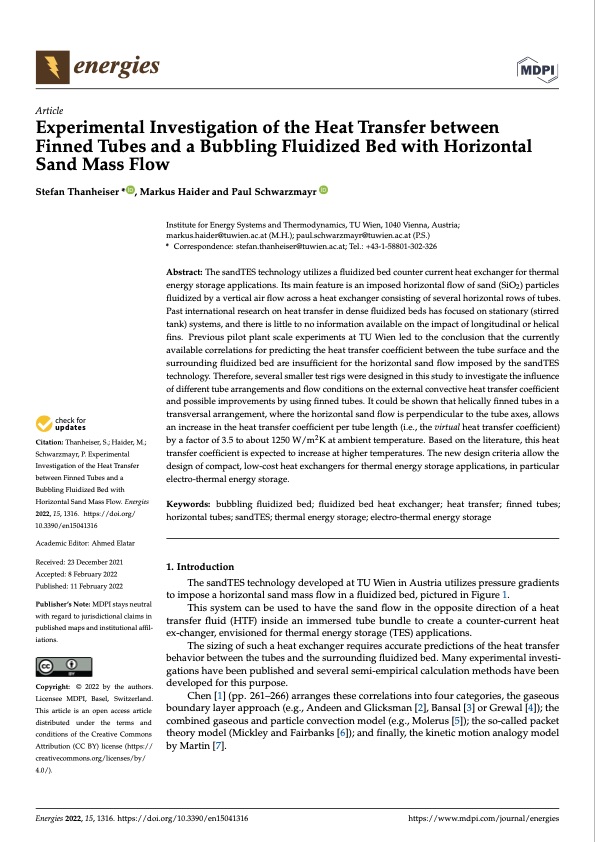
PDF Publication Title:
Text from PDF Page: 001
energies Article Experimental Investigation of the Heat Transfer between Finned Tubes and a Bubbling Fluidized Bed with Horizontal Sand Mass Flow Stefan Thanheiser * , Markus Haider and Paul Schwarzmayr Institute for Energy Systems and Thermodynamics, TU Wien, 1040 Vienna, Austria; markus.haider@tuwien.ac.at (M.H.); paul.schwarzmayr@tuwien.ac.at (P.S.) * Correspondence: stefan.thanheiser@tuwien.ac.at; Tel.: +43-1-58801-302-326 Abstract: The sandTES technology utilizes a fluidized bed counter current heat exchanger for thermal energy storage applications. Its main feature is an imposed horizontal flow of sand (SiO2) particles fluidized by a vertical air flow across a heat exchanger consisting of several horizontal rows of tubes. Past international research on heat transfer in dense fluidized beds has focused on stationary (stirred tank) systems, and there is little to no information available on the impact of longitudinal or helical fins. Previous pilot plant scale experiments at TU Wien led to the conclusion that the currently available correlations for predicting the heat transfer coefficient between the tube surface and the surrounding fluidized bed are insufficient for the horizontal sand flow imposed by the sandTES technology. Therefore, several smaller test rigs were designed in this study to investigate the influence of different tube arrangements and flow conditions on the external convective heat transfer coefficient and possible improvements by using finned tubes. It could be shown that helically finned tubes in a transversal arrangement, where the horizontal sand flow is perpendicular to the tube axes, allows an increase in the heat transfer coefficient per tube length (i.e., the virtual heat transfer coefficient) by a factor of 3.5 to about 1250 W/m2K at ambient temperature. Based on the literature, this heat transfer coefficient is expected to increase at higher temperatures. The new design criteria allow the design of compact, low-cost heat exchangers for thermal energy storage applications, in particular electro-thermal energy storage. Keywords: bubbling fluidized bed; fluidized bed heat exchanger; heat transfer; finned tubes; horizontal tubes; sandTES; thermal energy storage; electro-thermal energy storage 1. Introduction The sandTES technology developed at TU Wien in Austria utilizes pressure gradients to impose a horizontal sand mass flow in a fluidized bed, pictured in Figure 1. This system can be used to have the sand flow in the opposite direction of a heat transfer fluid (HTF) inside an immersed tube bundle to create a counter-current heat ex-changer, envisioned for thermal energy storage (TES) applications. The sizing of such a heat exchanger requires accurate predictions of the heat transfer behavior between the tubes and the surrounding fluidized bed. Many experimental investi- gations have been published and several semi-empirical calculation methods have been developed for this purpose. Chen [1] (pp. 261–266) arranges these correlations into four categories, the gaseous boundary layer approach (e.g., Andeen and Glicksman [2], Bansal [3] or Grewal [4]); the combined gaseous and particle convection model (e.g., Molerus [5]); the so-called packet theory model (Mickley and Fairbanks [6]); and finally, the kinetic motion analogy model by Martin [7]. Citation: Thanheiser, S.; Haider, M.; Schwarzmayr, P. Experimental Investigation of the Heat Transfer between Finned Tubes and a Bubbling Fluidized Bed with Horizontal Sand Mass Flow. Energies 2022,15,1316. https://doi.org/ 10.3390/en15041316 Academic Editor: Ahmed Elatar Received: 23 December 2021 Accepted: 8 February 2022 Published: 11 February 2022 Publisher’s Note: MDPI stays neutral with regard to jurisdictional claims in published maps and institutional affil- iations. Copyright: © 2022 by the authors. Licensee MDPI, Basel, Switzerland. This article is an open access article distributed under the terms and conditions of the Creative Commons Attribution (CC BY) license (https:// creativecommons.org/licenses/by/ 4.0/). Energies 2022, 15, 1316. https://doi.org/10.3390/en15041316 https://www.mdpi.com/journal/energiesPDF Image | Heat Transfer between Finned Tubes

PDF Search Title:
Heat Transfer between Finned TubesOriginal File Name Searched:
energies-15-01316.pdfDIY PDF Search: Google It | Yahoo | Bing
Turbine and System Plans CAD CAM: Special for this month, any plans are $10,000 for complete Cad/Cam blueprints. License is for one build. Try before you buy a production license. More Info
Waste Heat Power Technology: Organic Rankine Cycle uses waste heat to make electricity, shaft horsepower and cooling. More Info
All Turbine and System Products: Infinity Turbine ORD systems, turbine generator sets, build plans and more to use your waste heat from 30C to 100C. More Info
CO2 Phase Change Demonstrator: CO2 goes supercritical at 30 C. This is a experimental platform which you can use to demonstrate phase change with low heat. Includes integration area for small CO2 turbine, static generator, and more. This can also be used for a GTL Gas to Liquids experimental platform. More Info
Introducing the Infinity Turbine Products Infinity Turbine develops and builds systems for making power from waste heat. It also is working on innovative strategies for storing, making, and deploying energy. More Info
Need Strategy? Use our Consulting and analyst services Infinity Turbine LLC is pleased to announce its consulting and analyst services. We have worked in the renewable energy industry as a researcher, developing sales and markets, along with may inventions and innovations. More Info
Made in USA with Global Energy Millennial Web Engine These pages were made with the Global Energy Web PDF Engine using Filemaker (Claris) software.
Sand Battery Sand and Paraffin for TES Thermo Energy Storage More Info
| CONTACT TEL: 608-238-6001 Email: greg@infinityturbine.com | RSS | AMP |